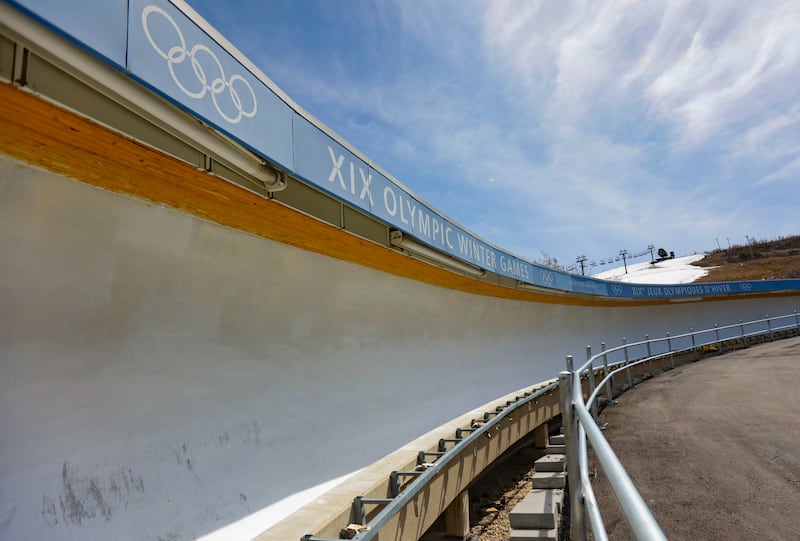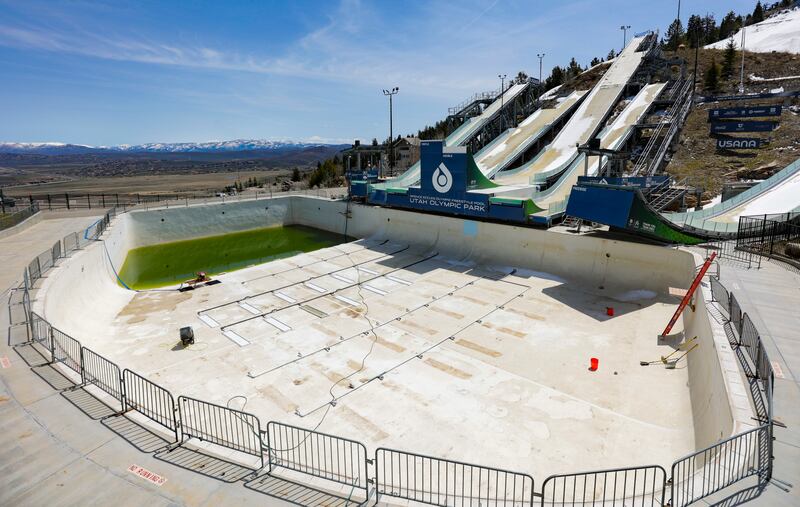Another Olympics in Utah carries a price tag of $2.2 billion.
But that’s only if Salt Lake City is selected by the International Olympic Committee over Sapporo, Japan; Vancouver, Canada; and Barcelona, Spain; to host the 2030 Winter Games. If the IOC decides the 2034 Winter Games would be a better fit, that adds another 10% or so to the bottom line.
So who’s going to pick up the check if Utah’s bid succeeds?
It won’t be Utah taxpayers, said Fraser Bullock, president and CEO of the Salt Lake City-Utah Committee for the Games bidding to bring the Olympics back. The money to pay the bills would be raised largely from the sale of sponsorships, tickets and broadcast rights, he said, just like for the 2002 Winter Games in Salt Lake City.
Beyond the total, the budget being prepared for a future Olympics has not yet been made public, but Bullock, who served as chief operating officer of the 2002 Games, said it should be available soon and detailed some of the largest revenue and expense categories for the Deseret News.
“We’re very open in terms of giving you a good feeling for the budget. So it does not require any taxpayer money from Utah. That number is zero,” Bullock said. The federal government is required by a presidential directive to provide security for major national events like the Olympics, he said, an expenditure not in the budget.

What’s different than 2002?
Two decades ago, Utah taxpayers had invested $59 million to build Olympic venues including ski jumps, a bobsled, luge and skeleton track, and a speedskating oval even before the bid was awarded. The money was repaid from the 2002 Games’ surplus, along with a sizable endowment that has kept the venues running.
There’s no new construction needed to host a future Games, so the $1.5 billion spent in 2002 ends up being about $200 million more when inflated to 2030 dollars than the proposed price tag for hosting again, Bullock said, promising another Olympics will be “a net contributor to tax revenues in Utah.”
But the economic impact from the 2030 Winter Games will be “slightly lower” than the $6.5 billion in today’s dollars from 2002 because the Olympic venues and other infrastructure is already in place, said Natalie Gochnour, director of the Kem C. Gardner Policy Institute at the University of Utah.
“The economic impact isn’t quite as significant but it’s still noteworthy, for sure,” Gochnour said, although the exact estimate being put together for the bid won’t be ready until mid-summer. “We are looking at this carefully,” she said, promising “a rigorous treatment” of the financial implications for Utahns.
Gochnour said Utah taxpayers should be reassured that so much is already in place for another Olympics, especially the expertise needed to pull off a profitable event.
“One of the things that makes Salt Lake City and Utah so attractive is our track record, our success, our experience. But also we can do it in a more fiscally appropriate way,” she said, adding that for taxpayers, “there’s less risk because we’ve done it before.”
Risk management, though, is an expense that’s spiked since 2002, thanks to COVID-19.
The 2020 Summer Games in Tokyo, Japan, were delayed a year due to the deadly virus, adding nearly $3 billion to the $12.6 billion budget. Tokyo organizers said they ended up spending less because spectators were banned, but actual costs are believed to be as much as double that.
In 2002, Utah’s Olympic organizers paid about $4 million for cancellation insurance, Bullock said. For 2030, he said more than 10 times that amount, $47 million, would be spent because “this time, we know it’s a bigger risk so we set aside a very big number. And that’s just to buy insurance.”
The issue of the IOC stepping up to offer more protection against future Games’ losses due to unforeseen circumstances was raised nearly two years with the IOC, in a 2020 letter seeking “deep collaboration” in the area of risk mitigation.
Bullock had little to say about whether the IOC would be willing now to share more of the risk.
“I would just leave it there,” he said, agreeing that remains a big priority for the bid.
“It is consistent with that letter, that we just want to collaborate on risk management. Part of that is in our planning and how flexible we are in our planning for different things that could happen,” Bullock said, such as holding off on as much spending as possible “until the very end” in case of any delays.

Utah, not Salt Lake City, may sign IOC contract
The Utah Legislature has already pledged in a 2020 resolution that the state will be responsible for staging the Olympics. Two decades ago, the state indemnified Salt Lake City against any losses because the city was required to sign the host city contract with the IOC.
Now, under the IOC’s new, less formal bid process intended to promote sustainability and keep the expense of hosting the Olympics down, that contract can be signed by a state, so an indemnification agreement with Salt Lake City wouldn’t be needed, Bullock said.
“All of the details would need to be worked out and the agreement signed to be fully binding,” he said. “But the clear intent is to move forward.”
Rocky Anderson, mayor of Salt Lake City during the 2002 Games, said there were tensions then over what he called an “informal sort of handshake” between state and city leaders over indemnification, which resulted in a public dispute over security funding.
Still, Anderson supported the Olympics.
“At that point, I mean, it was a done deal. My view was, make it the very best we can make it and go work on making it financially viable as well as something that will reflect really well on our community, something we can be really proud of,” he said. “And that’s what ended up happening.”
Anderson, a longtime attorney involved in civil rights who now serves as volunteer executive director of the Justice Party, expressed excitement about bringing the Olympics back to Utah but stressed the importance of the public knowing what could go wrong.
“We all deserve total transparency,” he said. “We need to know what are the worst downsides. Is there a possibility that taxpayers are going to be on the hook? What if they don’t raise enough private money? We all deserve to know what the contingencies are.”
Even then, there will be some Utahns who don’t agree “that having a great Olympic experience in a host city and neighboring communities is all that important. I happen to think that it’s fantastic,” Anderson said, because he’s “very much into the idea of nations coming together in peace and people getting to know each other better.”
What the numbers say
Bullock said taxpayers can be confident about the finances of a future Games.
“Look at history. We did it last time. We paid back $59 million. We paid for all of the public expenses of law enforcement that were local. We left behind a $100 million surplus, which has kept all of our venues alive and expanded sport in Utah. And we have all of our venues built right now,” he said.
“You add all that up and it points directly to a Games that doesn’t need any Utah taxpayer money.”
There’s also considerable wiggle room in the 2030 budget, with a $200 million contingency fund and another $300 million anticipated to be used after the Games for legacy purposes, Bullock said, mostly adding to the endowment for the venues and helping to promote sports through the Utah Sports Commission.
That puts actual expenses at $1.7 billion, with Games operations as the largest category at some $700 million, he said, including everything from holding test events beforehand to running the Olympic Village athlete housing at the University of Utah to transportation costs during the Games, as well as the risk insurance premium.
Other big expenses are labor, technology and what’s called “overlay,” the bleachers, tents and trailers set up at the venues during the Games, Bullock said, noting that in 2002, there were some 700 tents and another 700 trailers needed.
The biggest single source of revenue is the IOC, the source for an estimated $500 million from what broadcasters around the world would pay the Switzerland-based organization to air the Games in their countries, plus another $200 million from the sales of international corporate sponsorships, Bullock said.
The amounts in other key revenue categories, such as the sale of tickets and U.S. corporate sponsorships, are still being worked out, he said. Because Los Angeles already has the 2028 Summer Games, concerns have been raised that back-to-back Olympics in the same country could reduce what domestic sponsors would be willing to pay.
“Anything we do has to fit into their plans,” Bullock said. As talks continue with L.A. organizers and the U.S. Olympic and Paralympic Committee, which shares in domestic sponsorship revenues, he said it’s been made clear Utah is “pursuing 2030 until we’re not.”
What that means, Bullock said, “is we’re working hard to make all of the components work. We believe it can work. But there’s work yet to be done.” So Utah is continuing to pursue both the 2030 and 2034 Winter Games, which could be awarded at the same time under the new IOC bid process.
Olympic observers have said that’s likely what the IOC will do and see Salt Lake City and Sapporo as the likely picks. There’s no timeline for a decision, but U.S. Olympic leaders have said the field should be narrowed in the coming months, possibly to a single candidate, with a final vote expected in 2023.
What COVID-19 means for the bid
Matthew Burbank, a political science professor at the University of Utah who has written two books about the Olympics, said there was uncertainty about how the 2002 Winter Games would be paid for among Utahns. But he said there wasn’t significant opposition to that bid and likely won’t be to this one, either.
Long before the pandemic’s impact on the past two Olympics, the 2002 Games had its own financial fallout to deal with, from an international scandal over Salt Lake City’s efforts to buy IOC votes, followed by the Sept. 11, 2001, terrorist attacks on the United States.
Mitt Romney, now a U.S. senator from Utah, was brought in to lead the organizing committee after the scandal and hired Bullock and others. When the terrorist attacks came just months before the Games were set to begin, the federal government poured additional money into security to send a message that the Olympics would be safe.
While 9/11 was “a wake-up call” about the risks associated with holding an international event, Burbank said the COVID-19 pandemic that started more than two years ago demonstrates just how different the world could be by the 2030 or 2034 Winter Games.
“Things could change in ways that we can’t plan for easily and so what do we do then, if there’s something that happens that means we can’t hold the Games or people can’t travel or whatever it might be,” the professor said, requiring a tough look at potential pitfalls as part of the bid.
“The risk of that happening again probably isn’t that high, but I think what it does is it highlights this sense everybody has that, ‘Wow, these kinds of things can happen and we have to take them seriously,’” he said. “Last time when we were bidding ... nobody talked about these kinds of things. Nobody was concerned with them.”


